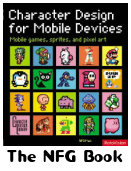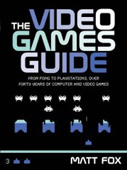Game On!: From Pong to Oblivion – The 50 Greatest Video Games of All Time
Simon Byron, Ste Curran and David McCarthy
Headline, £14.99
ISBN: 978-0755315703
This rather awkwardly titled volume is a slickly presented celebration of the best experiences gaming has to offer, as chosen by three veteran games writers (who these days can be found getting up to harmless mischief on their blog).
It isn’t, obviously, an uncompromising attempt to determine the 50 best games ever made. The authors don’t disguise the fact that the aim of the book is to present a catalogue of worthwhile gaming experiences that would be accessible to the mainstream reader. Each game is given 2-8 full colour pages, explaining the premise of the game (as well as other games in the series/franchise where appropriate) and what’s so good about it, as well as providing brief directions on how each game can be (legally) obtained and played. Each entry is lavishly illustrated with screenshots, artwork and concept art.
The introduction goes into quite a bit of detail regarding how the games were chosen, and in the majority of cases clear justification is given for inclusion. There are the worthy ‘ancient’ games (Asteroids, Pac-Man, Pong, Space Invaders and Tetris) which still stand up today. There are the ‘no brainers’, the classics from the past 10-15 years that are universally recognised (Final Fantasy VII, Half-Life, Super Mario 64, GTA3, etc.), which of course includes eight pages on Resident Evil 4. There are also some games included to tick the boxes of things mainstream gamers are likely to be looking for (i.e. sports games, music games, Eyetoy, The Sims, driving, shooting), leading to some odd but explainable choices such as Madden 2006 and Battlefield 1942 – not exactly landmarks in their respective genres, but adequate and likely to be stocked by GAME.
Filling the gaps are a few games that don’t fit into any of the aforementioned categories, which seem to mainly be included on the basis of the authors’ personal preferences. Some of these are the lightweight, campy, style-over-substance confections of the kind that tended to tiresomely championed by Edge at the time of Curran and McCarthy’s tenure on that publication: Dance Dance Revolution, Jet Set Radio Future, Dead or Alive 4 – none of which have any place in a list like this, least of all DOA4, considering there are already two other (better) fighting games included on the list (Street Fighter II and Soul Calibur II) and Virtua Fighter 4 is absent. DDR’s inclusion is also needless considering Guitar Hero is also on the list, and all ‘music’ games are essentially the same (hence the best one available renders all predecessors obsolete).
One choice that is inoffensive enough but somewhat puzzling is Broken Sword, included as the sole ambassador for trad adventure games (there are no LucasArts games on the list). Of course with only 50 places available, there are plenty of entire developers’ ouevres (and thanks to the focus on ease of availability, entire platforms) that have been overlooked. There’s no Sonic, Castlevania or Metroid. Nothing from Id, Bullfrog or Sensible. In a couple of instances the authors cheekily bend their own rules, including Bangai-O and the original Out Run (an absolutely worthy choice, but good luck finding a hydraulic cabinet to play it properly).
Putting aside criticisms of the authors’ personal taste, the quality of the writing is commendable. Adopting a conversational style that is enthusiastic, lucid and informative, it manages to succinctly summarise each game without over-generalising or patronising the reader. Some of the older games (on which there’s little to say that everyone doesn’t know already) get slightly sloppy and disinterested writeups, and the feeble attempts at humour (as anyone familiar with the authors’ previous work will be unsurprised to learn) tend to be irritating, yet are mercifully rare.
Game On! convincingly achieves its stated goals, and although it might be seen as redundant to anyone familiar with the featured games, I wouldn’t hesitate to recommend it as a fine starting point for the game-curious. Someone should send Boris Johnson a copy.

Character Design for Mobile Devices
Lawrence “NGFman” Wright
Rotovision, £29.99
ISBN: 978-2940361120
Don’t be fooled by the title – this book is essentially an excuse to geek out on a load of pixel art from various handheld and mobile formats. The decision to present the book as some sort of sober, instructional handbook on pixel art appears to have been taken at the behest of the book’s publisher.
A wealth of material is included. The challenges of producing graphics for mobile phone games are discussed (although only examples from a tiny handful of studios is featured). There are also extensive sections dedicated to a wide range of handhelds (including the Neo Geo Pocket Color, Bandai Wonderswan and Sega Game Gear), “sprite histories” for long-running, platform-spanning 2D game series such as Sonic, Mario and Castlevania, and interviews and profiles of several prolific commercial pixel artists (including the surprisingly under-recognised Henk Nieborg – although, overall, most of the artwork featured is of Japanese origin).
At the original pricepoint (£29.99) this book was rather hard to justify purchasing, when you consider that most of the imagery is available online and that there’s only so much that can be said about the minutiae of creating pixel graphics and the tricks used to give the suggestion of more detail. I’d advise checking it out first hand before splashing the cash, unless you can’t get enough of this stuff (and have an eboy bedspread).

The Video Games Guide
Matt Fox
Boxtree, £16.99
ISBN: 978-0752226255
Five minutes flicking through this book was enough to know that it should be avoided. It’s an extraordinarily incompetent attempt to create a Halliwell-style guide to games, an ambitious and worthwhile objective which is frustrated somewhat by the fact that whereas Halliwell’s Film Guide boasts 23,000 entries selected by a staff of editors and contributors, “The Video Games Guide” contains fewer than 1,000 entries, selected in stream of consciousness fashion by one guy who nobody has ever heard of.
The paucity of material is emphasised by the space-wasting layout (where even a redirection entry takes up roughly one eighth of a page), and waffling, anecdotal descriptive prose which manages to be impressively obtuse (for example the entry on Pong avoids any use of the word “tennis”). It’s hardly worth pointing out that the book lacks an adequate system of notation for indicating platforms, developers, publishers, alternate titles or any other reference data.
As a result of these shortcomings, whether by intention or simply through lack of ability, the Guide comes across as a cynical cash-in squarely aimed at nostalgia-blinded lapsed gamers. Unfortunately, at the moment it’s the only book of its kind available (apart from the Digital Press guides, which are closer to collector’s catalogues than review guides).
Tags: books, character design for mobile devices, game on, video games guide

